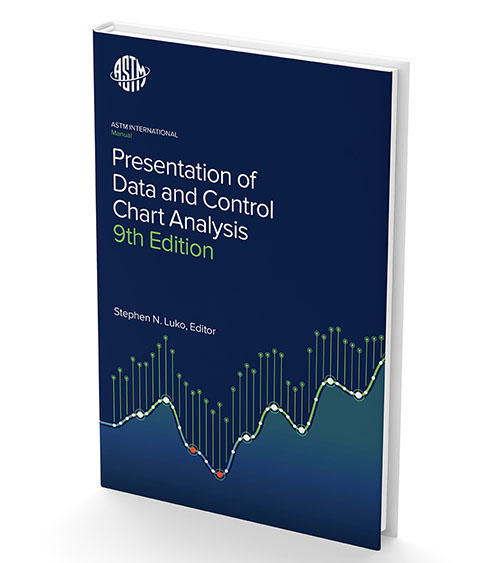
The committee on quality and statistics (E11) was officially established in 1946, and its first chairman was the statistician Harold F. Dodge.
By Stephen N. Luko and John Carson
Mar 12, 2025
The committee on quality and statistics (E11) was officially established in 1946, and its first chairman was the statistician Harold F. Dodge. Dodge himself was long associated with methods and standards concerning acceptance sampling, among other statistical techniques. To be sure, there was an earlier associated effort initiated in 1930 by the now-defunct committee on methods of testing (E1). This was technical committee IX, a shared effort between ASTM International and the American Society of Mechanical Engineers (ASME). That committee, chaired by Walter Shewhart, was charged with developing statistical methods in engineering and manufacturing. A subcommittee (SC) of this group, chaired by Dodge, led to the development of the ASTM Manual on Presentation of Data. Later, both E11 and the American Society for Quality Control (now ASQ) were created in 1946. Many people served and worked in both organizations, as continues to this day. In the 1970s, E11 opened its participation to all interested ASTM members. This greatly increased membership and participation, and today, many members have associations with other committees and work in a variety of industries. Over the years, the committee has continued to expand its footprint, with the addition of many new standards and subcommittees.
An early key document predating E11 as well as ASQ, the original ASTM Manual on Presentation of Data was issued by a special committee in 1933. Following the formation of E11, this publication became Manual 7, On the Presentation of Data and Control Chart Analysis, under the jurisdiction of E11. The manual has been continuously updated and published since its original edition, and in 2018, saw its ninth edition (see image). Many texts and other publications on statistical process control (SPC) reference Manual 7 as an original source on key SPC topics. A more complete telling of the early days of E11 and of Manual 7’s historical editions may be found in ASTM’s Presentation of Data and Control Chart Analysis, 9th ed., and "Statistical Standards and ASTM," Quality Engineering, Vol. 22, Issue 4, 2010.

Today, E11 comprises approximately 269 members. There are five technical subcommittees:
E11.10 on sampling and statistics
- E11.20 on test method evaluation and quality control
- E11.30 on statistical quality control
- E11.40 on reliability
- E11.50 on metrology
- E11.70 on editorial & terminology
In addition, there are several administrative subcommittees:
- E11.85, outreach, support and interpretation
- E11.90, executive
- E11.91, planning
A key document within E11 is the standard practice for conducting an interlaboratory study to determine the precision of a test method (E691), first published in 1979. The interlaboratory study (ILS) has become a mainstay for many industrial laboratories throughout the country. In recent years, ASTM also began to require that committees address precision and accuracy of their test methods. There followed the creation of several other standard practices and guides addressing various aspects of precision and bias. Additional standards were also added on the determination and treatment of uncertainty of measurement. Most of these standards fall under E11.20. Starting in the 1990s, an effort to develop standards addressing classical SPC topics took off. There followed new standards on basic statistics; control charts; process capability; simple regression analysis; and measurement systems analysis.
Another effort that started in the 1990s and was completed in the last decade was the preservation of certain military standards on acceptance sampling—the so-called MIL-STDs. A number of these old military standards had become "obsolete" or at least were not being updated anymore. However, these standards had a long history in industry and continued to be used by many companies. E11, under the leadership of the late Dr. Edward Schilling, began the task groups that created the conversion of these MIL-STDs to ASTM form and style. During the conversion process, few if any changes were made to the technical portions of the standards. The goal was to preserve the original content as much as possible, but some errors were uncovered and corrections made. In addition, the numerous tables contained in these standards were checked for accuracy and corrected or reformatted where necessary. Today, there are seven standards under this banner:
- Standard practice for use of process oriented AOQL and LTPD sampling plans (E1994)
- Standard practice for sampling a stream of product by attributes indexed by AQL (E2234)
- Standard practice for sampling a stream of product by variables indexed by AQL (E2762)
- Standard practice for single- and multi-level continuous sampling of a stream of product by attributes indexed by AQL (E2819)
- Standard guide for preferred methods for acceptance of product (E2910)
- Standard practice for factors and procedures for applying the MIL-STD-105 plans in life and reliability inspection (E2555)
- Standard practice for life and reliability testing based on the exponential distribution (E2696)
Two of the MIL-STD conversions in the list relate to reliability demonstration testing: E2696 for products and components whose life distribution is of the random (exponential) type; and E2555 for products and components whose life distribution is of a more general Weibull type. In recent years, E11 has created another subcommittee on general reliability (E11.40) and both E2696 and E2555 were transferred here. Since that transfer, two additional standard guides have been created: the standard guide for general reliability (E3159) and the standard guide for reliability demonstration testing (E3291). Reliability is an important part of modern engineering and quality. Additional standards are planned on other topics in reliability.
E11
A key document within E11 is the standard practice for conducting an interlaboratory study to determine the precision of a test method.
One challenge that E11 has had to contend with over the years concerns terminology. E11’s terminology document (E456) houses all terms that are contained and originate in the portfolio of E11 technical standards. Many if not all committees use statistics to some degree, and some committees have their own statistical terminology unique to their applications. This is true of basic statistics as well as sampling and reliability applications. It is E11’s general strategy to try to provide definitions of its terms in order to harmonize as much as possible with similar terms that may be encountered in other technical committees. It is also desirable to have an overall ASTM repository of statistical terms that may be called upon or referenced by other committees when needed. E456 functions as this repository.
In 1978, E11 created a committee award honoring its first chairman, Harold Dodge. Since that time, 14 individuals have been awarded the Harold F. Dodge Award for outstanding technical contributions. E11 will continue to grow and maintain its present portfolio of standards. The entire portfolio can be reviewed on the ASTM website.
Stephen N. Luko is a retired fellow and statistician at United Technologies Corp/Collins Aerospace. He is chair of the subcommittee on reliability (E11.40); a member of the quality and statistics committee (E11); an ASTM International fellow; Harold F. Dodge Award recipient; and a former E11 chair.
John Carson, Ph.D., is senior statistician for Neptune and Co. and the Data Points column coordinator. Carson is a member of the committees on quality and statistics (E11); petroleum products, liquid fuels, and lubricants (D02); air quality (D22); environmental assessment, risk management, and corrective action (E50); and personal protective clothing and equipment (F23).
March / April 2025


